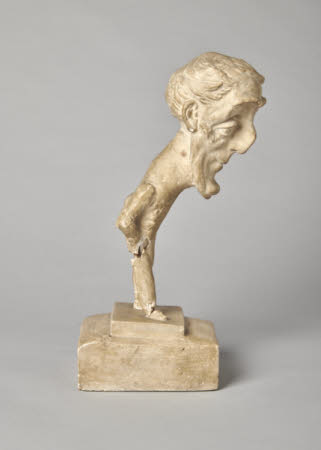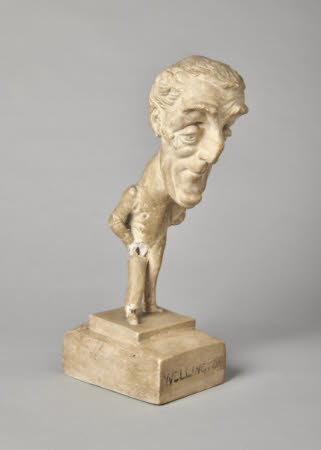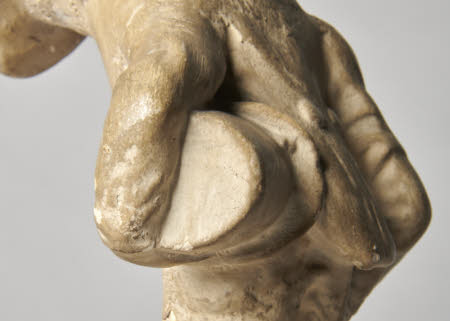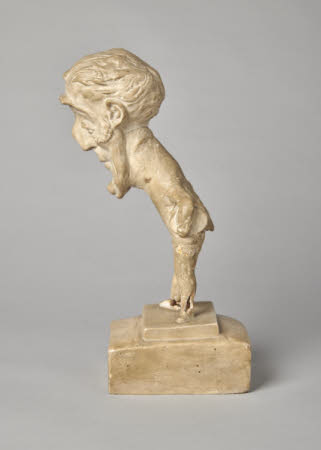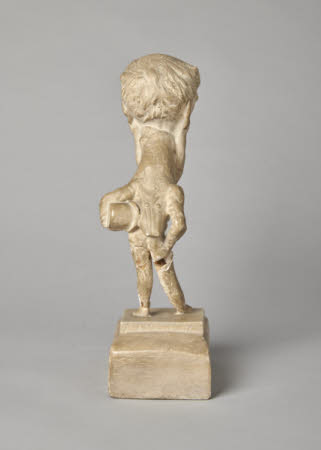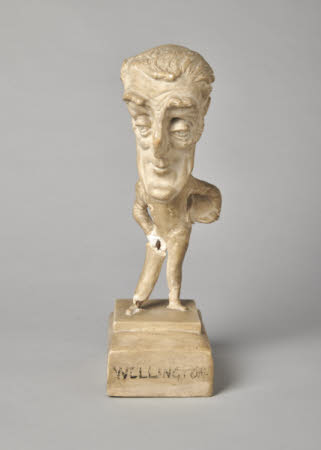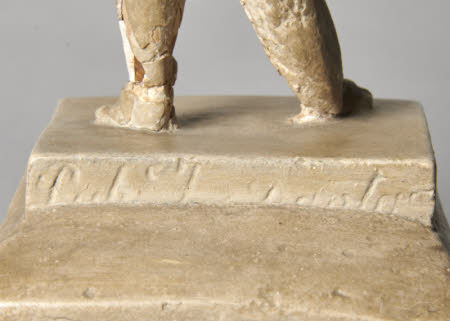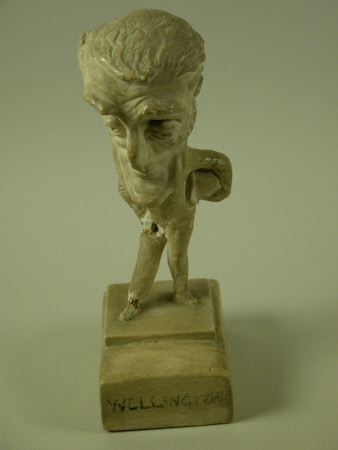Portrait statuette of Arthur Wellesley, 1st Duke of Wellington (1769-1852)
Jean-Pierre Dantan (Paris 1800 - Baden-Baden 1869)
Category
Art / Sculpture
Date
1833 - 1834
Materials
Plaster
Measurements
330 x 128 x 196 mm
Order this imageCollection
Mount Stewart, County Down
NT 1221044
Summary
Sculpture, patinated plaster; Arthur Wellesley, 1st Duke of Wellington, KG, KB, MP (1769-1852); Dantan jeune (Jean-Pierre Dantan, 1800-1869); 1833-34. A caricature statuette of the Duke of Wellington, a this time a minister in the government. One of a group of seven such caricatures, known in French as ‘portraits chargés’ or ‘charges’, made by the French sculptor and satirist Dantan jeune during his first stay in London in 1833, brought to Mount Stewart from Londonderry House.
Full description
A portrait chargé or caricature of Arthur Wellesley, 1st Duke of Wellington (1769-1852), depicting the Duke in civilian dress wearing a frock coat, his hat held under his left arm, leaning forward with a somewhat unctuous if benevolent expression. On a small integral rectangular base, set in turn on a larger rectangular base, on which is inscribed at the front in ink WELLINGTON. The artist’s signature on the back of the small pedestal, partly visible. The right leg is broken in two places, revealing the armature, and there is also damage to the left leg. The son of an ornamental sculptor Antoine-Joseph-Laurent Dantan (1762-1842), Jean-Pierre Dantan began to learn his art as a boy in his father’s studio, taking delight in drawing in charcoal onto the walls caricature portraits of visitors to the studio. He entered the École des Beaux-Arts in Paris in 1826 or 1827 and first exhibited at the Salon in 1827, with eight portrait busts. He called himself Dantan jeune, Dantan the younger, to distinguish himself from his older brother, who was aso a practising artist. Dantan made portrait sculptures throughout his life, his sculpted portraits becoming the most significant panorama of leading personalities in Paris, from the 1830s onwards. Alongside this successful and busy career as a portrait sculptor, Dantan became famous for his remarkable sculpted caricatures, a type of sculpture known in French as ‘portraits chargés’ (literally ‘loaded portraits’) or simply ‘charges’. Hardly less than his sculpted portraits, these portraits chargés encompass a very large number of prominent personalities, including politicians, writers, musicians and actors. Dantan made his first charges as early as 1826, and started to reproduce them from 1831 and to market them commercially from 1832, working with several publishers, notably Susse Frères, whose shop in the Passage des Panoramas had a permanent display of Dantan’s caricatures, updated constantly as new ones were created. The charges became astonishingly popular in the early 1830s, the fashion for them lasting for around ten years. At its height it was for many people a boost to the their social status to be caricatured in this way, and Dantan even found himself being approached by people begging to be depicted by him (Seligman 1957, p. 54). Susse Frères not only made and sold the plaster and bronze copies of Dantan’s works, but from around 1834 also began to publish the caricatures as lithographs, in albums known as the Museum Dantanorama; the lithograph caricatures also appeared in the journal Le Charivari. Already in the late 1830s Dantan had begun to arrange his works in his studio in Paris in the form of an exhibitable collection, which he called the Musée Dantan, and which became quite a tourist attraction. The contents of his museum remained intact and is today in the Musée Carnavalet in Paris, which thus owns by far the most complete collection of Dantan’s sculpture (Sorel 1986 and 1989). The overwhelming majority of Dantan’s subjects were French, but he also made a small number of charges of British personalities, during two stays in London, in 1832-33 and in 1834. These have been described as ‘as savage in treatment as any of his works’ (Seligman 1957, p. 75) and as some of the most original and caustic of his caricatures (Sorel 1989, p. 32). The caricatures targeted members of the Royal family, the government and parliamentarians in particular. The collection of seven figures now at Mount Stewart includes several politicians, as well as two notable Frenchmen living at the time in London, Talleyrand and the comte d’Orsay. Dantan certainly benefited from the more liberal political conditions in London, although it seems he may have had to flee Britain at short notice at the end of his second stay. He never sought to take on the French authorities in similar manner, and such criticism was in any event forbidden in France under a new law promulgated in 1835. During the short-lived craze for it in the 1830s, Dantan jeune's work was hardly less popular in London than it was in France, and he had distinguished patrons, including the Marquess of Londonderry and the Duke of Devonshire, with whom he stayed at Chatsworth in 1842. A contemporary account of Dantan’s museum by a well-informed Parisian physician Felix Andry, writing under the name of Dr Viro, drew particular attention to the sculptor’s foray into the world of British subjects, commenting that the sculptures enjoyed a great success among the Parisian public, who loved the ridiculing of a degenerate monarchy and over-wealthy aristocracy. He also suggested that the French perhaps also found in Dantan’s creations some vengeance for the defeat of Waterloo, less than twenty years before (Viro 1863, pp. 33-34, 81-84). According to Viro, no publisher or shop in London dared to handle the satirical sculptures, so Dantan had to sell them from his lodgings: ‘However, every day the most elegant carriages would stop at his address, no. 18 Leicester Square, and the great men themselves and great wits quickly realised they too should laugh at their own caricatures and even admit them into their own drawing rooms.’ (‘Mais chaque jour les plus élégants équipages venaient s'arrêter devant son n° 18, Leicester square, et les grands hommes eux-mêmes, gens d'esprit, eurent bientôt pris le parti de rire de leurs propres charges et de les admettre dans leurs salons.’ The group of seven charges by Dantan jeune in the Londonderry collection is thought to have been bought by the Fourth Marquess of Londonderry (1805-72), who when young was a great friend of the comte d’Orsay, one of Dantan's victims, and his companion the Countess of Blessington. The collection was apparently found at Mount Stewart at some time in the early twentieth century and was then taken to Londonderry House in London, where it was displayed in the Library. The whole group was exhibited in 1931 at the Burlington Fine Arts Club, in an exhibition on English caricature. The portrait of the Duke of Wellington is relatively restrained by Dantan jeune's standards, and has been described as ‘a fine likeness of the great man but bearing a more genial expression than is usually associated with him.’ (Seligman 1957, p. 75). It was reproduced by Dantan as one of the plates in his album of lithographs, the Museum Dantanorama. Janet Seligman suggested that the statuette may have been made to make amends for what must have been a more savage image of the Duke as a headless figure, exhibited in Vienna in 1933, but there is no other record of this figure and no image, and the much smaller size suggests that this was in fact an example of the Mount Stewart figure that had at some point lost its head. Dantan seems to have been on good terms with the Duke of Wellington, as he also made a charming naturalistic portrait bust of a small child, dated 24 August 1833, which according to the inscription by Dantan on the bust was an illegitimate child of the Duke with ‘Lady … ‘, unfortunately not further identified (Sorel 1989, p. 237, no. 446). Jeremy Warren April 2022
Provenance
Probably acquired by Frederick Stewart, 4th Marquess of Londonderry (1805-1872); by descent at Mount Stewart and Londonderry House; given to the National Trust by Lady Mairi Bury (1921-2009) in 1976
Marks and inscriptions
Front of large base:: WELLINGTON Back of base, incised: : Pub’d by Dantan
Makers and roles
Jean-Pierre Dantan (Paris 1800 - Baden-Baden 1869), sculptor
References
Londonderry House 1939: A Catalogue and Valued Inventory of the Furniture and Works of Art at Londonderry House, Park Lane, W... Prepared for the purposes of insurance, with historical notes, by H. Clifford-Smith, 1939, p. 142. Muséum Dantanorama: Muséum Dantanorama, lithographié par Grandville, Hamelet et Lepeury, Susse and Neuhaus, Paris, undated (but from 1834), Pl. 19. Viro 1863: [Félix Andry} Charges et bustes de Dantan jeune. Esquisse biographique, dédiée à Méry, par le docteur Prosper Viro, Paris 1863, p. 83. Burlington Fine Arts Club: ‘Catalogue of a Collection of English Caricature, Winter 1931/1932’, London 1931, no. 208. Vienna 1933: Die Karikaturen des Dantan. Paris-London 1831-1839, exh. cat., Kunsthistorisches Museum, Vienna 1933, p. 6, no. 5. Montgomery Hyde 1937 H. Montgomery Hyde, Londonderry House and its Pictures, London 1937, p. 18, Pls. IV and XV. Hale 1940 : Richard Walden Hale, Dantan, jeune 1800-1869, and his satirical and other sculpture, especially his “portraits chargés’, Needham, Mass. 1940. Seligman 1957: Janet Seligman. Figures of fun: the caricature-statuettes of Jean-Pierre Dantan, London 1957., pp. 75-76, 86, 146. Sorel 1986: Philippe Sorel, ‘Les Dantan du Musée Carnavalet. Portraits-charges sculptés de l’époque romantique’, Gazette des Beaux-Arts,, 107 (1986), pp. 1-38 and 87-102, p. 100, no. 322. Sorel 1989: Philippe Sorel, ‘Dantan jeune. Caricatures et portraits de la société romantique’, exh. cat., Maison de Balzac, Paris 1989., p. 77, no. 9.
